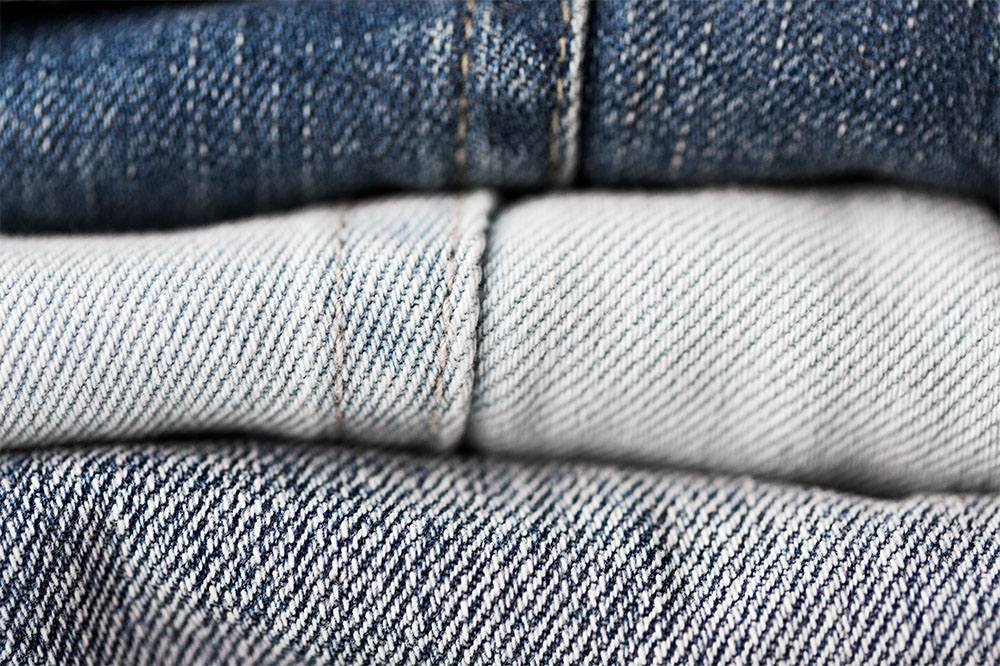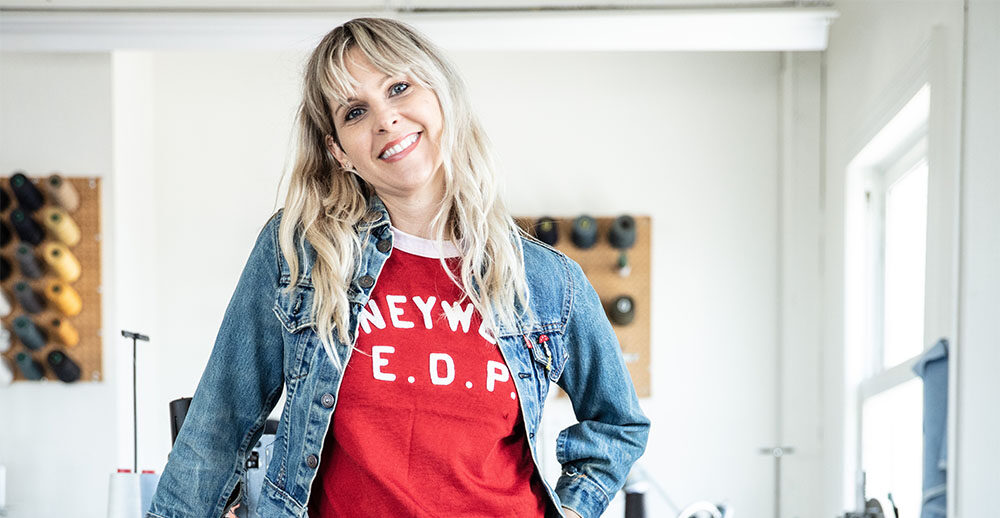Trend forecaster, jean expert, and mastermind behind Denim Dudes: Amy Leverton knows what she’s talking about when it comes to denim and all that’s happening in the world of indigo. In a recent chat with Leverton, we got a glimpse of where the industry is today, and where it’s going from here. Keep reading for our insightful conversation.
Material Exchange: How did you come to start Denim Dudes?
Leverton: I started out as a designer, and then worked in trend forecasting at one of the leading consumer trend forecasters, WGSN. I ran the denim department, and as a secret side project, I started working on a book about denim street style. I featured notable characters wearing denim, and looked into the why behind their style choices. When you write a book, people understand you mean business – so I set up Denim Dudes as a company in Los Angeles.
ME: Can you explain what exactly you do at Denim Dudes?
Leverton: Our company DNA is trend forecasting, which is all about generating ideas on what people are going to be wearing in the future. We work a lot with mood boards and sketches. We listen to culture, we read articles, we’re on Instagram and Tiktok all the time. We dive into what people are talking about, what’s the potential, what brands are doing, what their designs mean and why. We look at garments and connect the dots. With all of this information, we put together presentations for clients to help them figure out where to go next. We’re really small, but we do a lot.
ME: You’ve worked together with the denim Kingpins Show, which is now a part of the Material Exchange community. Can you talk about your collaborations with Kingpins?
Leverton: I started working together with Kingpins whilst at WGSN, presenting our trend forecasting at the Kingpins denim trade show. When I started Denim Dudes, Andrew Olah [the founder of Kingpins] asked me to create in-house trend reports. Everyone wanted the latest seasonal trends in denim, and Andrew saw the value it would add for Kingpins to bring it in-house. We had the autonomy to do it how we wanted and focus on what was important for the denim industry instead of squeezing it into a general apparel trend report. We’ve continued to create these denim trend reports for Kingpins – two each year – which has brought huge value. Looking ahead, we’re excited to work with Material Exchange on integrating QR codes and fabric swatches into the report so it’s more of a digital experience.
ME: Speaking of digital experiences, how do you see digitization and 3D design playing a role in the denim industry?
Leverton: Across the industry, we’re all moving toward more efficient and less wasteful operations, which rely heavily on digital processes. It’s hard to forecast how popular a garment will be, so creating digital versions instead of physical will help eliminate brands sitting on inventory and will also cut down on waste in fast fashion.

ME: What do you see as the biggest problems in the denim industry right now?
Leverton: The apparel industry as a whole is a dirty industry, and denim manufacturing is one of the dirtiest within it. The indigo dying process is much more water- and energy-intense than most other dying. The consumption of cotton for jeans is much higher than for most other cotton garments. Denim is one of the only garments that you dye, and then wash the dye back out through additional treatments – it’s a process that’s heavy in water consumption and pollution.
ME: What solutions exist for these problems?
Leverton: Denim mills are getting better, and our goal for our recently launched Denim Directory reports was to help designers understand how they can do better and understand what fabrics are less damaging. Designers don’t have time to do lots of sustainability research on their own, so platforms like Material Exchange as well as the information we provide in our Denim Directory can help them to make smarter choices.
ME: How do you see the denim industry changing in the next five to ten years? How might this affect the various stakeholders?
Leverton: LA has traditionally been a denim hub with many denim brands and factories based here. But over the last ten to fifteen years, we’ve seen a drop in local manufacturing. Then, during Covid, there was an uptick. [Sustainable denim manufacturer] Saitex came in – they’re prioritizing low-impact production hand-in-hand with technology and have some great minds streamlining their denim operations.
Now, there are a lot more boutique denim manufacturers here in LA who are more sustainability minded. When it comes to implementing sustainability measures, the set-up costs are huge, but in the long run, it saves money and, most importantly, resources like water.
ME: What advice do you give to denim brands in the current climate?
Leverton: Make more sustainable choices at every point along the way. Find the time to do better; it can be a matter of making a few small changes to create a better jean.
As sustainability in denim becomes a bigger priority for most players in the business, change is inevitable – but the question is when and how it will happen. Getting your business on track for sustainability can feel overwhelming, but as Leverton says, it can be about making small changes toward a big impact. Digitizing your operations is an important first step to decreasing waste, increasing efficiency, and getting ahead of your competition. And Material Exchange can help do just that. If you’d like to learn more, check out our offerings for suppliers here and for brands here.
For a sustainability focus to your digitization journey, you may also want to register for our new Sustainability Exchange. Whether you’re looking for responsibly-produced materials or have your own recycled, organic, or low-impact materials to promote, you’ll have a secure, digital space of like-minded businesses on this exchange.
If you’d like to meet Leverton in person and see her trend forecasting in action, she’ll be attending the upcoming Kingpins Show in New York this July. Thank you, Amy, for your insights into the denim industry of today – and for your work toward a better tomorrow!
*Top featured photo of Amy Leverton by Yoshi Miyazaki
Check out our webinars
We’ve got a wide range of informative, inspiring webinars in our library of events. Take a look to find one that sounds interesting. And feel free to reach out if there’s something you’d like us to cover that you don’t see!
Related content
Want to chat?
We’d love to hear from you. Reach out to see how we could work together.





